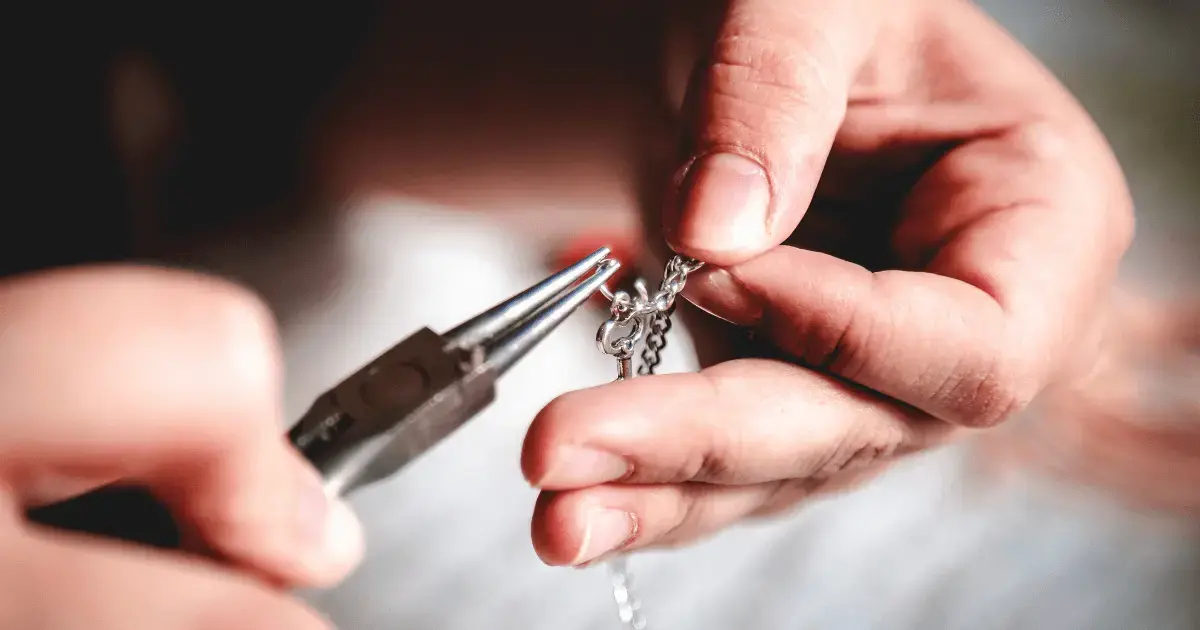
The jewelry repair industry is on the rise, expected to reach a valuation of $9 billion by 2033. Offering repairs, sizings, stone replacements, and custom work is an incredible way to boost your foot traffic and revenue.
But if you choose to offer custom jewelry orders and repairs in your store, you’ll face a new dilemma: Should you handle repairs in-house, or outsource them to a trade shop? Both options have pros, cons, and costs that can impact your business and your bottom line.
Which is the best option for your store?
This post breaks down the real costs of both approaches and explores the non-financial factors that should influence your decision about offering jewelry repairs. By the end, you'll have a clear framework for making the best call for your business.
Understanding the True Cost of In-House Jewelry Repairs
When you think about in-house jewelry repairs, what comes to mind? For most jewelry store owners, it's hiring a bench jeweler and setting up a workspace. But the true investment goes far deeper than that initial decision.
In-house jewelry repairs means bringing the entire repair operation under your roof. You’ll need not only a jeweler but also the equipment, workspace, insurance, and supplies associated with jewelry repair.
Many store owners underestimate the investment required and end up pricing repairs too low, turning what should be a profit center into a break-even operation at best.
Related Read: A Complete Checklist of Jewelry Repair Tools for Your Small Business
The costs of offering in-house jewelry repairs fall into four main categories:
- Equipment
- Labor
- Overhead
- Ongoing expenses
Each category carries both upfront and recurring costs that add up quickly. But when you price your repair services well and manage processes efficiently, you’ll make up for these costs and more. Let’s break down each of these four categories in more detail, helping you understand the true cost of in-house jewelry repairs. 
The Real Investment Required for In-House Jewelry Repairs
What is the cost of setting up your store for in-house jewelry repairs? Repairs are a profit center for your store, but they’re also a significant ongoing financial commitment, and you don’t want to be caught off guard.
Equipment costs are your first major hurdle. The initial setup will cost between $10,000 and $50,000, including jeweler's benches, jewelry repair tools, soldering equipment, polishing machines, ultrasonic cleaners, and safety equipment.
Salary and benefits represent your largest ongoing expense. A qualified bench jeweler will typically earn between $40,000 and $80,000 annually in salary alone. Then, you’ll need to account for benefits like health insurance, paid time off, and retirement contributions. In competitive markets, you may need to pay even more to attract the right talent.
Related Read: How To Become a Bench Jeweler in 7 Simple Steps
Space requirements are harder to quantify, as they’re more opportunity cost than upfront cost. You’ll need to dedicate square footage to a workshop space, meaning you’re sacrificing some of your retail space for repairs instead of sales.
Insurance increases are another inevitable cost. Adding repair operations means higher liability coverage to protect against damage or loss of customer pieces.
Supplies and materials create recurring costs for your store. Plan to invest in replacement stones, findings, polishing compounds, solder, and more each month.
Whether you do 10 repairs or 100, these costs stay fixed.
If you can’t keep your jeweler busy — or if your pricing doesn’t reflect your true cost per job — you’ll turn what should be a profit center into a time sink.
The Hidden Costs of Outsourcing Jewelry Repairs
We’ve covered the costs of in-house jewelry repairs, and they’re steep. If outsourcing is starting to look appealing, that’s no surprise. There is a lot to like about outsourcing jewelry repairs: no equipment, no full-time staff, just a mark-up added to your trade shop’s invoice to turn a small profit.
Related Read: 5 Tips To Attract High-Value Customers to Your Jewelry Store
Most jewelers underestimate how much time they lose managing outsourced repairs. You’re chasing invoices, calling trade shops, and explaining delays you didn’t cause.
Also, there are some hidden costs to outsourcing jewelry repairs:
Markup fees typically run 40-60% above the trade shop price (or two to three times the invoice amount). While this sounds like healthy profit, it can make your repair prices less competitive.
Shipping and handling costs add up fast. You're paying both ways, plus insurance for valuable pieces. Factor in packaging materials and staff time to coordinate shipments, and your profit margin shrinks even more.
Extended turnaround times are perhaps the biggest drawback. Adding days or even weeks to customer wait times can make customers anxious and impatient, hurting customer satisfaction with your store.
Quality control challenges are another concern. You're trusting another business to represent your standards. When work comes back subpar, you're stuck managing a situation you didn’t even create.
Customer perception is another important consideration. Many customers specifically choose your store for a repair, assuming they’ll get in-house service. Discovering their piece left your store to go to a generic trade shop can hurt trust and customer loyalty.
Outsourcing keeps your overhead low — but you trade control for convenience.
If speed, quality, and customer experience define your brand, outsourcing may save you money today but cost you loyalty tomorrow.
When Do In-House Jewelry Repairs Make Financial Sense?
In-house jewelry repairs can be a significant investment, but they’re worth it in the right context. But what are those situations where investing in in-house jewelry repairs actually pays off?
To see if your store should offer in-house services, start with a break-even analysis. Calculate your monthly repair volume against fixed costs. Most stores find that in-house operations start making financial sense around 20-30 repairs per month, but this varies based on your specific cost structure.
You’ll also need to consider your profit margins. At low volumes, you’ll want to outsource because you avoid those high fixed costs we discussed. However, if you have high volumes of repairs, in-house becomes more affordable because your fixed costs stay the same and your per-repair cost drops significantly.
Related Read: ANSWERED: How Much Does a Jewelry Store Owner Make?
Still unsure of which approach is right for you? Let’s talk through a few examples.
- A low-volume store handling fewer than 20 repairs per month should probably outsource; your fixed costs will likely overwhelm revenue.
- A medium-volume store processing 20-50 repairs monthly sits in break-even territory, where the decision depends on other factors.
- A high-volume store completing 50+ repairs monthly almost always profits more from in-house operations.
Regardless of which approach you choose, you’ll want to understand your true costs to the cent. This figure helps you price your repair services more accurately, helping you turn a profit without accidentally gouging your customers.
Non-Financial Factors That Impact Your Decision
The numbers matter, but they don’t tell the whole story. When deciding on outsourcing vs in-house jewelry repairs, you need to keep a few non-financial factors top of mind:
- Customer expectations: What does your clientele value most: lightning-fast turnaround, white-glove service, or price? High-end customers often expect in-house capabilities and direct interaction with the jeweler. Budget-conscious customers may care more about cost than speed.
- Repair complexity: If you primarily handle ring sizings, cleanings, and simple clasp replacements, the equipment and skill requirements are manageable. Intricate custom work, antique restoration, or specialty techniques will require a higher investment.
- Available skilled labor: Can you find and retain a qualified bench jeweler in your area? Many regions face a shortage as experienced jewelers retire. If talent isn't available, in-house operations are out of the question.
- Your business model: Retail-focused stores might view repairs as more of a nuisance than an advantage, and might prefer to outsource. Repair-driven stores treat them as a primary revenue stream, investing heavily in in-store repairs.
You might also decide to take a hybrid approach to your jewelry repair options. You can invest in the tools and staff you need to handle simple repairs like sizings and cleanings in-house, then outsource more complex or specialized work.
How The Right Tools Make In-House Jewelry Repairs More Profitable
If you choose to offer in-house repairs in your jewelry store, you’ll need to ensure you have the right infrastructure. Beyond just the space and the jeweler and the tools, you’ll need the right technology.
Your point of sale (POS) system needs to help you track and manage repair work. When choosing the right POS system for your jewelry business, you’ll need to keep an eye out for several key features:
- Work order management: Look for a solution that helps you track repair jobs from initial intake to final completion, with automated customer notifications when pieces are ready.
- Profitability tracking: Use sales data and reports to monitor costs versus revenue for each category — sizings, stone settings, custom work — so you can adjust pricing as needed.
- Inventory management: Track materials like findings, stones, and polishing compounds.
- Customer communication: SMS and email updates keep customers informed without tying up your staff on the phone.
- Integration with sales: When someone picks up a sizing, your system can flag their purchase history and use that data to promote new arrivals or upcoming collections that might meet their purchase profile.
The right system helps you price and manage repairs more efficiently, giving customers a better experience and making your in-house jewelry repair services more profitable.
Making the Right Choice for Your In-House Jewelry Repairs Strategy
Should you outsource jewelry repairs or handle them in-house? There’s no universal “right answer.” Your decision should be based on your estimated volume, available capital, local talent pool, and business goals.
Regardless of whether you choose to offer repairs in-house, outsource, or use a hybrid approach, you’ll need the right tools to track profitability and manage work orders. The most critical investment in your jewelry business’s success is the right point of sale solution.
Want to see how much more profitable your repair operations could be? Schedule a demo of Jewel 360 today to see how our all-in-one solution can help you make smarter decisions about in-house jewelry repairs and maximize your bottom line.




 by
by .png?width=101&height=101&name=Group%201%20(1).png)


